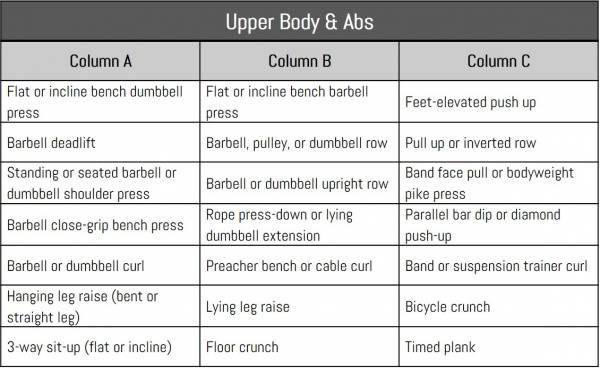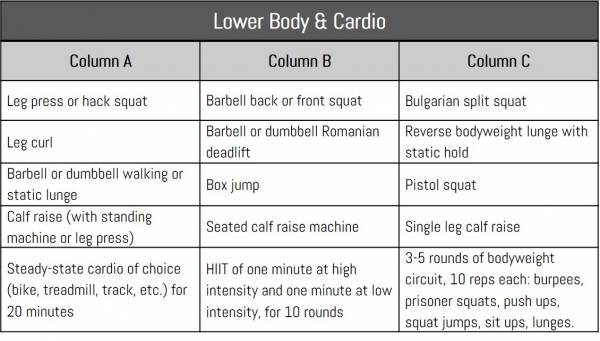Most training programs revolve around the nine-to-five worker. These programs set up the five-o’clock rush hour traffic, not only to the gym but also in it. It’s tough enough to muster the energy to actually make it to the gym. But once you’re there, you find long waits for equipment, people staring at their phones, and an atmosphere that can seem crowded, confusing, and disruptive. Your once perfectly laid-out plan is now challenged, fragmented, and utterly useless.
Of course, there is a certain amount of flexibility required. Your program needs to have fail-safes built in, so that you can easily adapt to any given situation without feeling overwhelmed and defeated. But that is much easier said than done. Switching things up on the fly isn’t a universal skill, especially for those of us who just want to get in a good workout without thinking into it too much. We’d rather have a plug-and-play type system in place for such times.
If all of that sounds like you, this is your training plan. This program is designed for those who want an easy-to-follow guide during those times when life (or a crowded gym) throws you a curve ball. It will help you get in and get your work done, rather than tuck your tail between your legs and go home regretting your decision. Additionally, it’s built with practicality in mind. No marathon sessions riddled with complex training techniques, the exclusive use of specific equipment, or the need to monopolize countless stations at your gym. Good? Good. Let’s get to it.
The Plug and Play Mindset
First, let’s establish some universal rules for anyone who wants to spend their gym time wisely.
- Be ready for anything. Sometimes the equipment you want won’t be available. Sometimes downtown traffic will leave you 20 minutes later to the gym than you wanted to be. The trick is to have plenty of tools at your disposal. Being able to adapt your plan on the fly will lessen your stress and frustration, and keep you on the right track to success.
- Practice flexibility. It’s not enough to always have your weapons at the ready, you’ll need to clock in plenty of practice. Every now and again, throw yourself a loop and switch things up on the fly. It’ll keep your adaptability skills honed, and keep your training interesting and progressive.
- Have a backup for everything. And a back-up to your back-up. Always be in the state of change. Having these plans pre-built will never get you out of whack and wondering what to do next.
- Trust that this will work. One of the most powerful tools is to believe what you’re doing will work. Faith in your plan leads to dedication and consistency, and with enough of those, your program really becomes secondary. Most sensible training plans will work with enough belief, hard work, and discipline to back them up. Don’t start with a plan; start with a belief that you will succeed, and the rest will follow.
The Plug and Play Training Plan
This plan is as realistic as it gets. However, there are a few unique requirements that need to be addressed in order for it to be as efficient and effective as possible:
- Keep workouts moderate to short in duration. No marathon sessions with countless sets and reps, just the necessities in the shortest time possible.
- Work as much of the body as possible. No micro body part splits; only one or two areas each day. You will train on a sensible split.
- Have back-up exercises at your disposal. You will always have alternatives for each day when the gym is a madhouse.
- No wasted effort. You’ll have zero time devoted to nonessential work. You’ll only focus on the movements that give you the biggest bang for your buck.
The joy of this plan is derived from its simplicity. First, you will set up your training frequency. I recommend hitting the gym every other day. You can do this on a rolling schedule, which will have you training on a weekend day, or you can choose a fixed schedule such as Monday, Wednesday and Friday.
Next, you will perform a simple upper/lower split by training your entire upper body and abs on one day, and your lower body and a short cardio session on the next.
Finally, you will choose a column to work from. Each column is designed to have its respective muscle groups included. Don’t feel obligated to choose an entire column. Feel free to mix and match from each row. For example, you may choose a chest exercise from column A, a back exercise from column B and the rest from column C, if you so desire. The choice is all yours.
Note: The exercises in columns A and B are traditional lifts, while column C is mostly bodyweight exercises.
Perform 3-4 sets of 8-12 reps on all exercises, with 30-60 seconds of rest in between sets. You can also perform all exercises in circuit fashion, with a 2-3 minute rest after each round.




Have even less time than this program asks for?






